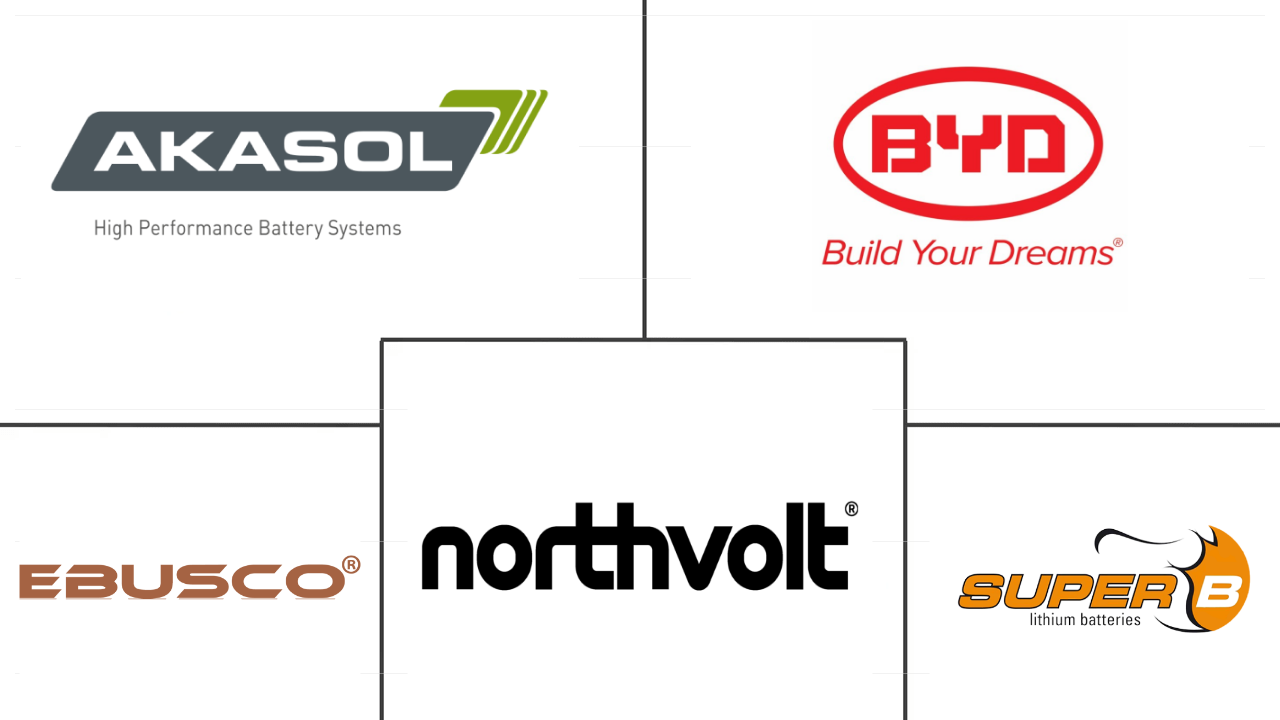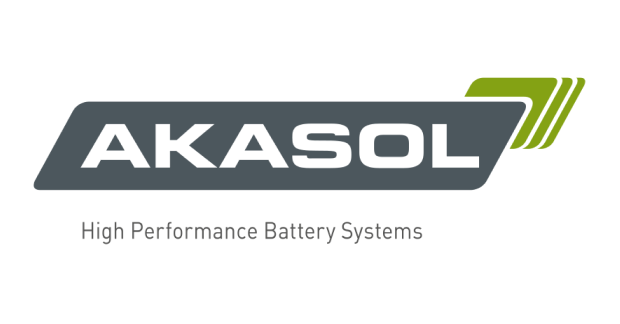Market Size of germany electric bus battery pack Industry
| Icons | Lable | Value |
|---|---|---|
|
|
Study Period | 2017 - 2029 |
|
|
Market Size (2024) | USD 19.09 Million |
|
|
Market Size (2029) | USD 72.7 Million |
|
|
Largest Share by Propulsion Type | BEV |
|
|
CAGR (2024 - 2029) | 30.66 % |
|
|
Fastest Growing by Propulsion Type | PHEV |
Major Players |
||

|
||
|
*Disclaimer: Major Players sorted in no particular order |
Germany Electric Bus Battery Pack Market Analysis
The Germany Electric Bus Battery Pack Market size is estimated at 19.09 million USD in 2024, and is expected to reach 72.7 million USD by 2029, growing at a CAGR of 30.66% during the forecast period (2024-2029).
19.09 Million
Market Size in 2024 (USD)
72.7 Million
Market Size in 2029 (USD)
91.10 %
CAGR (2021-2023)
30.66 %
CAGR (2024-2029)
Largest Segment by Propulsion Type
100 %
value share, BEV, 2023
The adoption of BEVs in the bus segment aligns with Germany's commitment to sustainable mobility and reducing carbon emissions in the transportation sector.
Largest Segment by Battery Chemistry
64.84 %
value share, NCM, 2023
Automakers and consumers in Germany's EV battery pack industry are interested in the NCM battery technology's ongoing development and the capability of quicker charging.
Largest Segment by Battery Form
42.56 %
value share, Pouch, 2023
Pouch battery dominates Germany's electric bus battery pack market, offering efficient space utilization and high energy density for enhanced performance and range.
Leading Market Player
22.40 %
market share, Akasol AG, 2022

Akasol specializes in high-energy lithium-ion battery systems, which are essential for electric buses due to their need for long range and reliable performance. This specialization allows Akasol to cater specifically to the needs of electric bus manufacturers.
Largest Segment by Capacity
46.91 %
value share, 40 kWh to 80 kWh, 2023
This battery capacity typically provides a sufficient driving range for most urban and suburban bus routes. This range is ideal for city buses, which make frequent stops and do not usually require the extended range that might be necessary for intercity buses.
The German electric bus battery pack market is expected to witness significant growth driven by a shift toward electric buses and government regulations
- The electric bus battery pack market in Germany is expected to see significant growth in the coming years. As of 2021, electric buses comprised around 10% of the country's total bus fleet, with over 3,000 electric buses in operation. By 2030, Germany aims to have all new buses purchased to be electric, leading to a potential sales volume of over 5,000 electric buses per year. Government regulations, environmental concerns, and the decreasing cost of battery technology drive this shift toward electric buses. The adoption of electric buses in Germany is expected to grow rapidly in urban areas, where air pollution is a major concern.
- With the growing demand for electric buses, the battery pack market is also seeing significant growth in Germany. Battery density and range have been steadily increasing over the years, and lithium-ion batteries have become the most widely used technology in the market. The cost of battery packs has also been decreasing, with a reduction of around 80% over the past decade. However, battery pack costs still remain a significant barrier to the adoption of electric buses, and further cost reductions are required to make electric buses more cost-competitive with diesel buses.
- The future of the electric bus battery pack market in Germany looks promising, with ongoing technological advancements and key battery pack manufacturers actively investing in research and development. Companies such as CATL, BYD, and Samsung SDI are among the key players in the market, with CATL being the largest supplier of battery packs for electric buses in Germany. Several ongoing research projects focus on improving battery technology and reducing costs.
Germany Electric Bus Battery Pack Industry Segmentation
BEV, PHEV are covered as segments by Propulsion Type. LFP, NCA, NCM, NMC, Others are covered as segments by Battery Chemistry. 15 kWh to 40 kWh, 40 kWh to 80 kWh, Above 80 kWh, Less than 15 kWh are covered as segments by Capacity. Cylindrical, Pouch, Prismatic are covered as segments by Battery Form. Laser, Wire are covered as segments by Method. Anode, Cathode, Electrolyte, Separator are covered as segments by Component. Cobalt, Lithium, Manganese, Natural Graphite, Nickel are covered as segments by Material Type.
- The electric bus battery pack market in Germany is expected to see significant growth in the coming years. As of 2021, electric buses comprised around 10% of the country's total bus fleet, with over 3,000 electric buses in operation. By 2030, Germany aims to have all new buses purchased to be electric, leading to a potential sales volume of over 5,000 electric buses per year. Government regulations, environmental concerns, and the decreasing cost of battery technology drive this shift toward electric buses. The adoption of electric buses in Germany is expected to grow rapidly in urban areas, where air pollution is a major concern.
- With the growing demand for electric buses, the battery pack market is also seeing significant growth in Germany. Battery density and range have been steadily increasing over the years, and lithium-ion batteries have become the most widely used technology in the market. The cost of battery packs has also been decreasing, with a reduction of around 80% over the past decade. However, battery pack costs still remain a significant barrier to the adoption of electric buses, and further cost reductions are required to make electric buses more cost-competitive with diesel buses.
- The future of the electric bus battery pack market in Germany looks promising, with ongoing technological advancements and key battery pack manufacturers actively investing in research and development. Companies such as CATL, BYD, and Samsung SDI are among the key players in the market, with CATL being the largest supplier of battery packs for electric buses in Germany. Several ongoing research projects focus on improving battery technology and reducing costs.
| Propulsion Type | |
| BEV | |
| PHEV |
| Battery Chemistry | |
| LFP | |
| NCA | |
| NCM | |
| NMC | |
| Others |
| Capacity | |
| 15 kWh to 40 kWh | |
| 40 kWh to 80 kWh | |
| Above 80 kWh | |
| Less than 15 kWh |
| Battery Form | |
| Cylindrical | |
| Pouch | |
| Prismatic |
| Method | |
| Laser | |
| Wire |
| Component | |
| Anode | |
| Cathode | |
| Electrolyte | |
| Separator |
| Material Type | |
| Cobalt | |
| Lithium | |
| Manganese | |
| Natural Graphite | |
| Nickel | |
| Other Materials |
Germany Electric Bus Battery Pack Market Size Summary
The Germany Electric Bus Battery Pack Market is poised for substantial expansion, driven by the country's commitment to transitioning its bus fleet to electric vehicles. This shift is fueled by government regulations, environmental concerns, and advancements in battery technology, particularly the decreasing costs of lithium-ion batteries. As urban areas grapple with air pollution, the adoption of electric buses is expected to accelerate, thereby boosting the demand for battery packs. Key players in the market, such as CATL, BYD, and Samsung SDI, are investing heavily in research and development to enhance battery technology and reduce costs, aiming to make electric buses more competitive with traditional diesel buses.
The market landscape is characterized by a diverse array of players, with major automotive companies like Volkswagen, Mercedes-Benz, Tesla, BMW, and Hyundai leading the charge in electric vehicle sales. These companies have established a strong presence in Germany, contributing to the growing demand for electric buses and their corresponding battery packs. The market remains fragmented, with significant contributions from companies such as Akasol AG, BYD Company Ltd., Ebusco B.V., NorthVolt AB, and Super B Lithium Power B.V. The ongoing technological advancements and strategic partnerships, such as the potential joint venture between Samsung SDI and BMW, underscore the promising future of the electric bus battery pack market in Germany.
Germany Electric Bus Battery Pack Market Size - Table of Contents
-
1. MARKET SEGMENTATION (includes market size in Value in USD and Volume, Forecasts up to 2029 and analysis of growth prospects)
-
1.1 Propulsion Type
-
1.1.1 BEV
-
1.1.2 PHEV
-
-
1.2 Battery Chemistry
-
1.2.1 LFP
-
1.2.2 NCA
-
1.2.3 NCM
-
1.2.4 NMC
-
1.2.5 Others
-
-
1.3 Capacity
-
1.3.1 15 kWh to 40 kWh
-
1.3.2 40 kWh to 80 kWh
-
1.3.3 Above 80 kWh
-
1.3.4 Less than 15 kWh
-
-
1.4 Battery Form
-
1.4.1 Cylindrical
-
1.4.2 Pouch
-
1.4.3 Prismatic
-
-
1.5 Method
-
1.5.1 Laser
-
1.5.2 Wire
-
-
1.6 Component
-
1.6.1 Anode
-
1.6.2 Cathode
-
1.6.3 Electrolyte
-
1.6.4 Separator
-
-
1.7 Material Type
-
1.7.1 Cobalt
-
1.7.2 Lithium
-
1.7.3 Manganese
-
1.7.4 Natural Graphite
-
1.7.5 Nickel
-
1.7.6 Other Materials
-
-
Germany Electric Bus Battery Pack Market Size FAQs
How big is the Germany Electric Bus Battery Pack Market?
The Germany Electric Bus Battery Pack Market size is expected to reach USD 19.09 million in 2024 and grow at a CAGR of 30.66% to reach USD 72.70 million by 2029.
What is the current Germany Electric Bus Battery Pack Market size?
In 2024, the Germany Electric Bus Battery Pack Market size is expected to reach USD 19.09 million.

